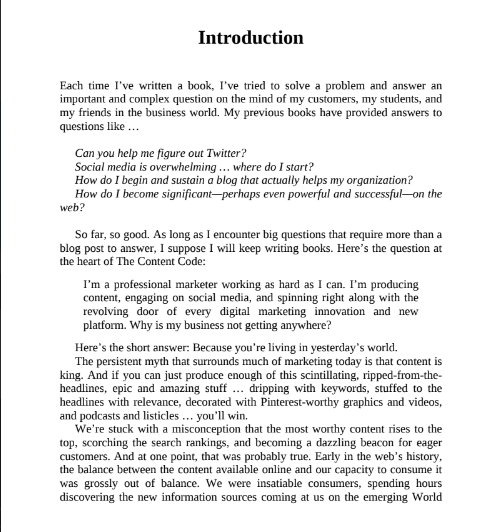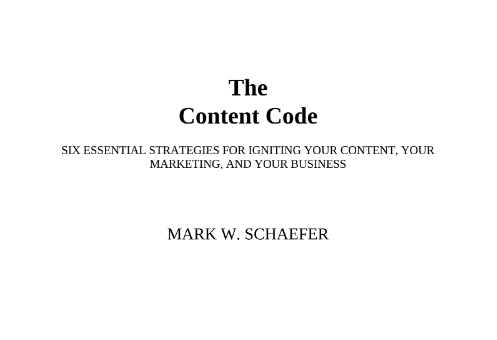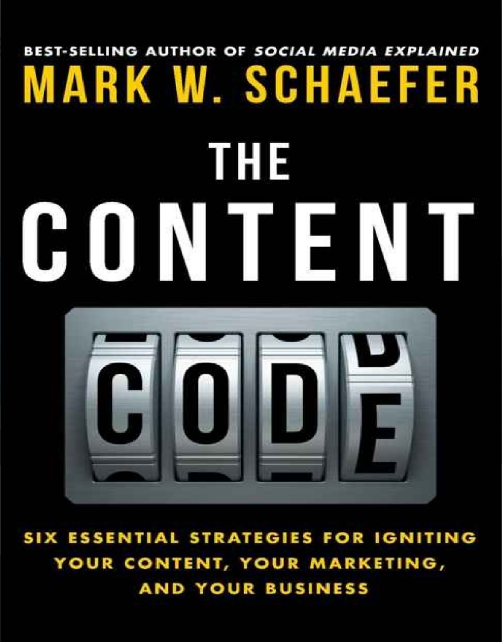


Each time I’ve written a book, I’ve tried to solve a problem and answer an important and complex question on the mind of my customers, my students, and my friends in the business world. My previous books have provided answers to questions like … Can you help me figure out Twitter? Social media is overwhelming … where do I start? How do I begin and sustain a blog that actually helps my organization? How do I become significant—perhaps even powerful and successful—on the web? So far, so good. As long as I encounter big questions that require more than a blog post to answer, I suppose I will keep writing books. Here’s the question at the heart of The Content Code: I’m a professional marketer working as hard as I can. I’m producing content, engaging on social media, and spinning right along with the revolving door of every digital marketing innovation and new platform. Why is my business not getting anywhere? Here’s the short answer: Because you’re living in yesterday’s world. The persistent myth that surrounds much of marketing today is that content is king.
And if you can just produce enough of this scintillating, ripped-from-the- headlines, epic and amazing stuff … dripping with keywords, stuffed to the headlines with relevance, decorated with Pinterest-worthy graphics and videos, and podcasts and listicles … you’ll win. We’re stuck with a misconception that the most worthy content rises to the top, scorching the search rankings, and becoming a dazzling beacon for eager customers. And at one point, that was probably true. Early in the web’s history, the balance between the content available online and our capacity to consume it was grossly out of balance. We were insatiable consumers, spending hours discovering the new information sources coming at us on the emerging World Wide Web. But the balance has shifted. Dramatically.
Every company, agency, club, university, non-profit organization, and 13- year-old kid hoping to break out as the next Katy Perry is pumping out content. Nearly everyone with access to the Internet has joined the content creation party. Selfies. Videos. Love poems. Songs. Infographics. Grumpy Cat. As you look at the future of this business landscape, there is no single trend that will have a more profound impact on how you market, where you market, and to whom you market than this overwhelming and uncontainable force of digital information density. Of course, if you’re currently working in marketing, PR, advertising, customer service, or sales, you already know that. The real question is, what do you do about it? Answering that question has become my obsession. Are we just going to let this tsunami of content take us under? Do we play by Facebook’s rules and hand over our money so we can reach our own hard-earned fans with our content? Do we just sit by and watch our great work become a de-valued commodity? No.
We need answers and ideas. We need alternatives. And that’s why we’re here. This is a book about hope, about breaking through this menacing wall of noise, and winning at marketing now—beyond content, beyond social media, beyond search engine optimization (if such a thing even exists any more). The Content Code starts where your current content marketing plan ends, for as you’ll find out, creating another blog post or video is probably the least of your worries. Creating great content is not the finish line. It’s the starting line. The imperative for your organization today is to unlock your content, unleash it, ignite it, and somehow convert it to measurable business value within this shrill world of overwhelming information. I’ve spent the last year studying this essential concept of content ignition, and it has changed me.
There is a science and psychology behind the act of sharing content that is awe-inspiring and beautiful and mesmerizing. People share content for hundreds of reasons, but there is a uniform process behind it inexorably linked to self-image, caring for others, and even compassion for an author or brand. It’s an astonishingly intimate experience, a precious symbol of trust and communion with our content that I had never considered before. I’ve also discovered that there is indeed a launch code for digital marketing success, a complex cocktail far beyond mere “promotion.” It’s a program that can nudge content to the top, help it become discovered, and unlock remarkable new economic value from the investment made in wonderful posts, pictures, podcasts, and other elements of marketing communications.
Life used to be so straightforward for marketers. Even 20 years ago, our options were limited. Advertise on TV, radio or print. Maybe throw in some billboards, PR, and trade shows for good measure. Those were the marketing channels in a nutshell. That’s where marketers maneuvered, every week, every month, and every annual budget cycle … with few exceptions. Today, the marketing platform options are changing by the day … and so are the rules of engagement! Let me explain what I mean. Let’s take a quick examination of the evolution of just one popular social media platform, Twitter. Twitter was founded in 2006. Within a few months, it became a beloved platform for communication in short bursts of 140 characters. But very rapidly, Twitter transformed dramatically—not necessarily because of any grand strategic business plan, but because businesses and faithful fans discovered so many remarkable and useful new ways to use it.
The ubiquitous hashtag was first used at a tech conference in 2007. Slowly it caught on and is now the preferred method of promoting, discovering, and organizing content. Twitter (the company) had nothing to do with this transformational innovation. Many marketers consider Twitter the greatest source of real-time research ever created. Some businesses are using advanced search strategies so effectively to grow their businesses that it has replaced advertising. Twitter chats, another “user” invention, have become big business. A cult of self-made Twitter chat stars are making a decent income from sponsored chats. Twitter has become the de facto “second screen” for TV viewing, amplifying content and advertisements to the point where tweet velocity is an important measurement in the traditional Nielsen television rating system.
Tweets are now being used for political polling, for defining consumer sentiment, for creating detailed buyer personas, and even for the inspiration to write new television plotlines. One blogger counted more than 300 independent applications dedicated to helping you manage, measure, and engage on Twitter.


